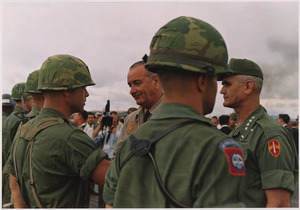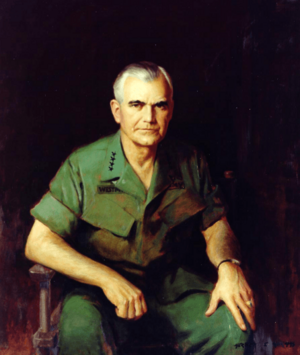William Westmoreland facts for kids
Quick facts for kids
William Westmoreland
|
|
|---|---|
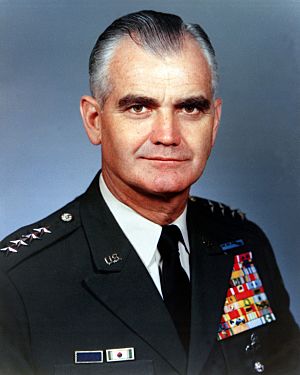
Westmoreland in 1969
|
|
| Nickname(s) | "Westy" |
| Born | March 26, 1914 Saxon, South Carolina, U.S. |
| Died | July 18, 2005 (aged 91) Charleston, South Carolina, U.S. |
| Buried |
West Point Cemetery
|
| Allegiance | United States |
| Service/ |
|
| Years of service | 1936–1972 |
| Rank | General |
| Service number | 0-20223 |
| Commands held | Chief of Staff of the United States Army Military Assistance Command, Vietnam XVIII Airborne Corps United States Military Academy 101st Airborne Division 187th Regimental Combat Team 504th Parachute Infantry Regiment 34th Field Artillery Battalion |
| Battles/wars | World War II Korean War Vietnam War |
| Awards | Army Distinguished Service Medal (4) Legion of Merit (3) Bronze Star Medal |
William Childs Westmoreland (March 26, 1914 – July 18, 2005) was a United States Army general. He is best known for leading U.S. forces during the Vietnam War from 1964 to 1968. After that, he became the Chief of Staff of the United States Army from 1968 to 1972.
Westmoreland used a strategy called attrition warfare in Vietnam. This meant trying to defeat the enemy by wearing them down. He aimed to reduce their soldiers and supplies. He also used America's strong artillery and air power. This included bombing North Vietnam. However, public support for the war in the U.S. decreased. This happened especially after big battles like the Battle of Khe Sanh and the Tet Offensive in 1968. When he left Vietnam, over 535,000 U.S. troops were there. His strategy did not lead to a political victory. Many U.S. soldiers were lost, and the draft made Americans unhappy. Also, many Vietnamese civilians were killed. This made people in South Vietnam less supportive.
Contents
Early Life and Education
William Childs Westmoreland was born on March 26, 1914. His family lived in Spartanburg County, South Carolina. They were involved in banking and textile businesses. When he was 15, William became an Eagle Scout. This is the highest rank in the Boy Scouts.
In 1932, he spent a year at The Citadel, a military college. Then, he was chosen to attend the United States Military Academy at West Point. He wanted to "see the world." He was a top student at West Point. He graduated as the "First Captain," the highest cadet rank. He also won an award for being the most skilled military cadet.
Military Career Highlights
After graduating from West Point in 1936, Westmoreland became an artillery officer. He served in different places, including Hawaii.
World War II Service
During World War II, Westmoreland fought in North Africa and Europe. He was part of the 9th Infantry Division. He commanded a field artillery battalion in Tunisia and Sicily. He rose to the temporary rank of colonel. By October 1944, he was the chief of staff for the 9th Infantry Division.
After World War II
After the war, Westmoreland trained as a paratrooper. He then led the 504th Parachute Infantry Regiment. From 1947 to 1950, he was the chief of staff for the 82nd Airborne Division. He also taught at military colleges.
Korean War Role
From 1952 to 1953, Westmoreland commanded the 187th Airborne Regimental Combat Team. This was during the Korean War. He was promoted to brigadier general in November 1952. At 38, he was one of the youngest U.S. Army generals at that time.
Before Vietnam
After the Korean War, Westmoreland held several important roles. He worked on manpower control for the Army. He also attended a management program at Harvard Business School. From 1958 to 1960, he led the 101st Airborne Division. Then, he became the Superintendent of the United States Military Academy from 1960 to 1963. In 1963, he was promoted to lieutenant general. He commanded the XVIII Airborne Corps before going to Vietnam.
Leading in the Vietnam War
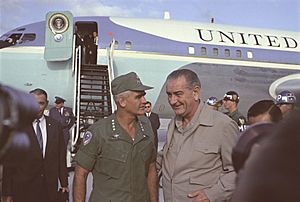
Westmoreland was sent to Vietnam in 1963. In January 1964, he became the deputy commander of Military Assistance Command, Vietnam (MACV). By June, he was the main commander. The Secretary of Defense, Robert McNamara, called him "the best we have."
As the head of MACV, Westmoreland often gave positive updates about the war. In 1965, TIME magazine named him "Man of the Year."
The number of U.S. troops in Vietnam grew a lot under his command. It went from 16,000 when he arrived to 535,000 in 1968. In April 1967, Westmoreland spoke to Congress. He said the enemy thought America would give up. He stressed that strong support at home was "vital to the success of our mission." He believed that with continued support, the U.S. would win. Westmoreland often said that U.S. forces "won every battle."
The Tet Offensive in 1968 was a major turning point. Communist forces attacked many cities and towns in South Vietnam. Westmoreland had been focused on the Battle of Khe Sanh. He thought the Tet Offensive was a trick. U.S. and South Vietnamese troops fought off the attacks. The communist forces suffered heavy losses. However, the strong attacks shocked the American public. People had believed Westmoreland's earlier positive reports. This led the Johnson administration to stop increasing U.S. troop numbers.
Westmoreland believed that the Vietnamese communists could be defeated. He thought this could happen by fighting a war of attrition. This meant wearing down the enemy until they could no longer fight. His strategy used a lot of artillery and airpower. He tried to get the communists into large battles. This would use America's superior firepower. He also said that killing Vietnamese civilians helped. He stated it "deprive[d] the enemy of the population." However, the North Vietnamese Army and Viet Cong avoided big battles. They continued guerrilla warfare. This wore down American public support faster than it wore down their own forces.
Westmoreland wanted to expand the war into Cambodia and Laos. This would cut off enemy supply routes. But this was not allowed by the U.S. government. He focused on "positive indicators" of progress. But these seemed wrong after the Tet Offensive.
In 1968, Westmoreland considered using nuclear weapons in Vietnam. This was part of a secret plan. But the White House stopped it when they found out.
Chief of Staff of the U.S. Army
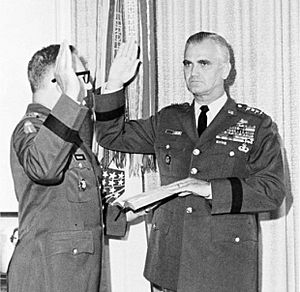
In June 1968, President Lyndon B. Johnson appointed Westmoreland. He became the Chief of Staff of the United States Army. This happened shortly after the Tet Offensive. Many in the media saw this as a punishment. They thought he was caught off-guard by the attacks.
Westmoreland served as Chief of Staff from 1968 to 1972. In 1970, he ordered an investigation. This was after the My Lai massacre by U.S. Army forces. The report showed problems with leadership in the Army. Westmoreland tried to make Army life better. He removed some strict rules to help with the move to an all-volunteer force.
Westmoreland retired from active service on June 30, 1972. He was offered another high position in Europe. But he chose to retire instead.
Later Years
After retiring, Westmoreland ran for Governor of South Carolina in 1974. He ran as a Republican but did not win. He published his autobiography the next year.
In 1986, Westmoreland led the Chicago Vietnam Veterans parade. This event helped to heal the divide between Vietnam veterans and the American public.
Westmoreland versus CBS
In 1982, CBS aired a documentary called The Uncounted Enemy: A Vietnam Deception. It claimed that Westmoreland had hidden the true number of Viet Cong troops in 1967. This was supposedly to keep up morale and public support. Westmoreland sued CBS for libel.
The lawsuit was called Westmoreland v. CBS. It was a long legal battle. Just before the jury was to decide, Westmoreland settled with CBS. They released a joint statement. Some believe Westmoreland's lawyers thought he would lose. Others point to testimony from his former intelligence officers. They said Westmoreland had ordered changes in intelligence reports for political reasons.
Views on the Vietnam War
In a 1998 interview, Westmoreland spoke about his opponent, North Vietnamese general Võ Nguyên Giáp. Westmoreland said Giap was a "formidable adversary." But he also said Giap fought a "big-unit war" with "terrible losses to his own men." Westmoreland believed Giap showed little regard for human life. He said, "An American commander losing men like that would hardly have lasted more than a few weeks." In a 1974 film, Westmoreland also said that "The Oriental doesn't put the same high price on life as does a Westerner. Life is plentiful, life is cheap in the Orient."
This view has been strongly criticized. Some historians say many Vietnamese killed were innocent civilians. They argue that U.S. policies and tactics led to these deaths. They also accused Westmoreland of hiding evidence of atrocities.
For the rest of his life, Westmoreland believed the U.S. did not lose the war. He said, "our country did not fulfill its commitment to South Vietnam." He felt that the U.S. "held the line for 10 years and stopped the dominoes from falling."
Personal Life
William Westmoreland married Katherine (Kitsy) Stevens Van Deusen in May 1947. They had three children: Katherine Stevens, James Ripley II, and Margaret Childs.
On July 7, 1968, Westmoreland was sworn in as Army Chief of Staff. Just hours later, his brother-in-law, Lieutenant Colonel Frederick Van Deusen, was killed in Vietnam. His helicopter was shot down.
Westmoreland passed away on July 18, 2005, at age 91. He had Alzheimer's disease in his final years. He was buried at the West Point Cemetery.
The General William C. Westmoreland Bridge in Charleston, South Carolina, is named after him. An award from the National Society of the Sons of the American Revolution is also named in his honor.
Images for kids
-
Westmoreland, President Johnson, South Vietnamese President Nguyễn Văn Thiệu and Prime Minister Nguyễn Cao Kỳ (left to right) in October 1966
Major Military Assignments
- Commander, 34th Field Artillery Battalion, 9th Infantry Division; 1943–1944
- Chief of Staff, 9th Infantry Division; October 13, 1944 to 1946
- Commander, 504th Parachute Infantry Regiment, 82d Airborne Division; 1946 to 1947
- Chief of Staff, 82d Airborne Division; 1947 to 1950
- Instructor, Army Command and General Staff College; 1950 to 1951
- Student, Army War College; 1951
- Instructor, Army War College; 1951 to November 1952
- 187th Airborne Regimental Combat Team; November 1952 to 1953
- Deputy Assistant Chief of Staff, G–1, for Manpower; 1953 to 1955
- Secretary of the General Staff; 1955 to 1958
- Commanding General, 101st Airborne Division; 1958 to 1960
- Superintendent, United States Military Academy; 1 July 1960 to 27 June 1963
- Commanding General, XVIIIth Airborne Corps; July 1963 to December 1963
- Deputy Commander, United States Military Assistance Command Vietnam; January 1964 to June 1964
- Commander, United States Military Assistance Command Vietnam; June 1964 to June 1968
- Chief of Staff, United States Army; July 3, 1968 to June 30, 1972
Military Awards
Westmoreland received many military awards, including:
- Combat Infantryman Badge
- Basic Army Aviator Badge
- Master Parachutist Badge
- Army Staff Identification Badge
- Army Distinguished Service Medal (with three bronze oak leaf clusters)
- Legion of Merit (with two Oak Leaf Clusters)
- Bronze Star Medal
- Air Medal (with nine Oak Leaf Clusters)
- Army Presidential Unit Citation
- American Defense Service Medal
- American Campaign Medal
- European–African–Middle Eastern Campaign Medal
- World War II Victory Medal
- Army of Occupation Medal
- National Defense Service Medal
- Korean Service Medal
- Vietnam Service Medal
- Foreign decorations and awards
- Knight Grand Cross of the Order of the Holy Trinity (Ethiopia)
- Legion of Honour, Knight (France)
- Croix de Guerre with bronze palm (France)
- Order of National Security Merit, Tong-Il Medal with Gold Star (Republic of Korea)
- Order of National Security Merit, Gukseon Medal (Republic of Korea)
- National Order of Vietnam, Knight Grand Cross (Republic of Vietnam)
- Republic of Vietnam Distinguished Service Order, First Class (Army)
- Republic of Vietnam Distinguished Service Order, First Class (Air Force)
- Republic of Vietnam Distinguished Service Order, First Class (Navy)
- Republic of Vietnam Gallantry Cross with Palm
- Republic of Vietnam Armed Forces Honor Medal, First Class
- Republic of Vietnam Civil Actions Medal, First Class
- Republic of Vietnam Chuong My Medal, First Class
- Order of Sikatuna, rank of Lakan (Commander) (Philippines)
- Most Exalted Order of the White Elephant, Knight Grand Cross (First Class) (Thailand)
- Order of Military Merit, Grand Officer (Brazil)
- Condecoracion al Mérito Militar "Prócer de la Libertad General de División José Miguel Lanza", Grand Officer (Bolivia)
- Order of the Rising Sun, class unknown (Japan)
- Order of the Cloud and Banner, Grand Cordon (Republic of China)
- Republic of Korea Presidential Unit Citation
- Vietnam Gallantry Cross Unit Citation
- Vietnam Civil Actions Medal Unit Citation
- United Nations Korea Medal
- Vietnam Campaign Medal
Other Awards
- Knox Trophy Award, for highest military efficiency as a cadet at West Point, 1936.
Dates of Rank
![]() United States Military Academy class of 1936
United States Military Academy class of 1936
| Second Lieutenant (Regular Army) |
First Lieutenant (Regular Army) |
Major (Army of the United States) |
Lieutenant Colonel (Army of the United States) |
Colonel (Army of the United States) |
|---|---|---|---|---|
| O-1 | O-2 | O-4 | O-5 | O-6 |
| 12 June 1936 | 12 June 1939 | 1 February 1942 (temporary) |
25 September 1942 (temporary) |
28 July 1944 (temporary) |
| Captain (Regular Army) |
Major (Regular Army) |
Brigadier General (Army of the United States) |
Lieutenant Colonel (Regular Army) |
Major General (Army of the United States) |
|---|---|---|---|---|
| O-3 | O-4 | O-7 | O-5 | O-8 |
| 12 June 1946 | 15 July 1948 | 7 November 1952 (temporary) |
7 July 1953 | December 1956 (temporary) |
| Colonel (Regular Army) |
Brigadier General (Regular Army) |
Major General (Regular Army) |
Lieutenant General (Army of the United States) |
General (Army of the United States) |
|---|---|---|---|---|
| O-6 | O-7 | O-8 | O-9 | O-10 |
| June 1961 | 14 July 1962 | 20 May 1963 | 31 July 1963 (temporary) |
1 August 1964 (temporary) |
Retired from active service in July 1972.
See also
 In Spanish: William Westmoreland para niños
In Spanish: William Westmoreland para niños


